GREETINGS FROM EARTH! Welcome to my space blog! Let's explore the stars together!!!
144 posts
Latest Posts by littlecadet-biguniverse - Page 4

M8 // Lagoon Nebula (left of center) & M20 // The Trifid (bottom)

Crab Pulsar at the core of the Crab Nebula
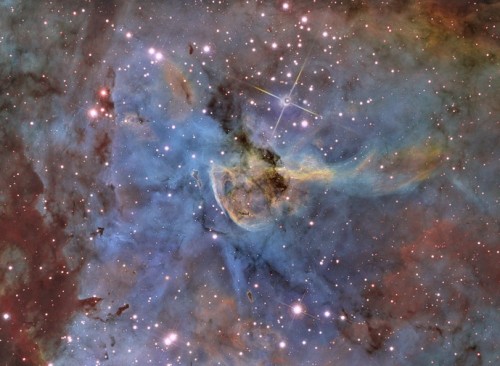
Eta Carinae and Keyhole Nebula (NGC 3324), inside the Carina Nebula (NGC 3372)

M7: Open Star Cluster in Scorpius : M7 is one of the most prominent open clusters of stars on the sky. The cluster, dominated by bright blue stars, can be seen with the naked eye in a dark sky in the tail of the constellation of the Scorpion . M7 contains about 100 stars in total, is about 200 million years old, spans 25 light-years across, and lies about 1000 light-years away. The featured wide-angle image was taken near the city of Belo Horizonte in Brazil. The M7 star cluster has been known since ancient times, being noted by Ptolemy in the year 130 AD. Also visible are a dark dust cloud on the lower right, and, in the background, literally millions of unrelated stars towards the Galactic center. via NASA
js

Nebula NGC 3603
js

Orion Nebula from HAWK-1 js

Hubble Spots a Secluded Starburst Galaxy : This image, taken by the NASA/ESA Hubble Space Telescopes Advanced Camera for Surveys
js

The most color rich region of night sky, the Milky Way Core and Rho Ophiuchi Complex
js

A cosmic concoction in NGC 2467
js

Hubbles Variable Nebula
js
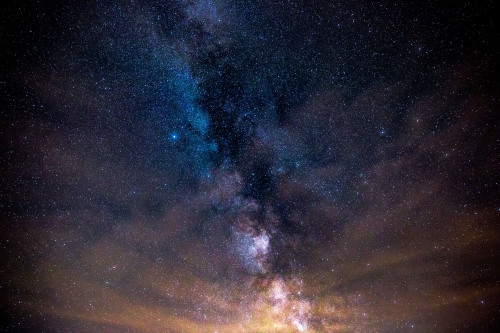
Milky Way js
Bubble Nebula by Hubble Heritage Via Flickr: For the 26th birthday of NASA’s Hubble Space Telescope, astronomers are highlighting a Hubble image of an enormous bubble being blown into space by a super-hot, massive star. The Hubble image of the Bubble Nebula, or NGC 7635, was chosen to mark the 26th anniversary of the launch of Hubble into Earth orbit by the STS-31 space shuttle crew on April 24, 1990. The Bubble Nebula is 7 light-years across — about one-and-a-half times the distance from our sun to its nearest stellar neighbor, Alpha Centauri. The Bubble Nebula was discovered in 1787 by William Herschel, a prominent British astronomer. It is being formed by a prototypical Wolf-Rayet star, an extremely bright, massive, and short-lived star that has lost most of its outer hydrogen and is now fusing helium into heavier elements. The star is about 4 million years old, and in 10 million to 20 million years, it will likely detonate as a supernova.
Credit: NASA, ESA, and the Hubble Heritage Team (STScI/AURA) heritage.stsci.edu/2016/13/ hubbledev.stsci.edu/newscenter/archive/releases/2016/13/

“Rho Ophiuchi Cloud Complex Area Of The Milky Way” by Martin Campbell on Flickr.
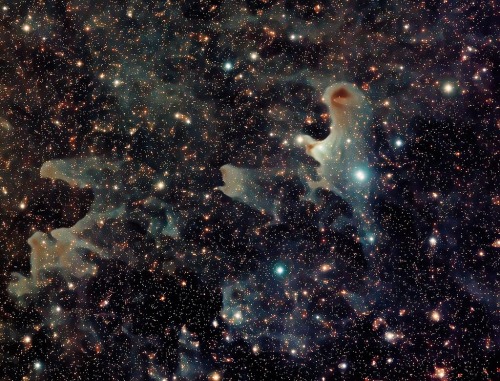
VdB 141 Region Nebulosity by Jeffrey Weiss on Flickr.
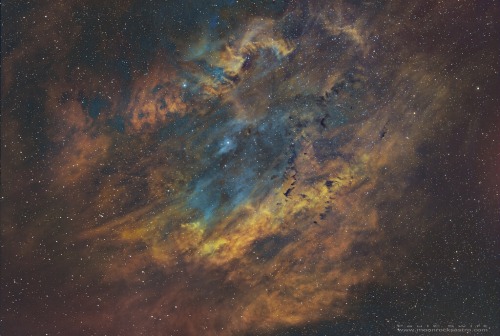
Sh2-119 Sharpless 119,emission nebular in Narrowband by Paul C. Swift on Flickr.

A ‘matryoshka’ in the interstellar medium
As if it were one of the known Russian dolls, a group of astronomers, led by researchers at the Instituto de Astrofísica de Canarias, (IAC) has found the first known case of three supernova remnants one inside the other. Using the programme BUBBLY, a method developed within the group for detecting huge expanding bubbles of gas in interstellar space, they were observing the galaxy M33 in our Local Group of galaxies and found example of a triple-bubble. The results, which were published yesterday in the journal Monthly Notices of the Royal Astronomical Society, help to understand the feedback phenomenon, a fundamental process of star formation and in the dissemination of metals produced in massive stars.
The group has been building up a data base of these superbubbles with observations of a number of galaxies and, using the very high resolution 2D spectrograph, GHaFaS (Galaxy Halpha Fabry-Perot System), on the 4.2 m William Herschel Telescope (WHT) of the Isaac Newton Group of Telescopes (Roque de los Muchachos Observatory, La Palma), has been able to detect and measure these superbubbles, which range in size from a few light years to as big as a thousand light years across.
Superbubbles around large young star clusters are known to have a complex structure due to the effects of powerful stellar winds and supernova explosions of individual stars, whose separate bubbles may end up merging into a superbubble, but this is the first time that they, or any other observers, have found three concentric expanding supernova shells.
“This phenomenon -says John Beckman, one of the co-authors on the paper- allows to explore the interstellar medium in a unique way, we can measure how much matter there is in a shell, approximately a couple of hundred times the mass of the sun in each of the shells”. However, if it is known that a supernova expels only around ten times the mass of the sun, where do the second and third shells get their gas from if the first supernova sweeps up all the gas?
The answer to that must come from the surrounding gas and in the inhomogeneous interstellar medium. “It must be -says Artemi Camps Fariña, who is first author on the paper-, that the interstellar medium is not at all uniform, there must be dense clumps of gas, surrounded by space with gas at a much lower density. A supernova does not just sweep up gas, it evaporates the outsides of the clumps, leaving some dense gas behind which can make the second and the third shells”.
“The presence of the bubbles -adds Artemi- explains why star formation has been much slower than simple models of galaxy evolution predicted. These bubbles are part of a widespread feedback process in galaxy disc and if it were not for feedback, spiral galaxies would have very short lives, and our own existence would be improbable”, concludes. The idea of an inhomogeneous interstellar medium is not new, but the triple bubble gives a much clearer and quantitative view of the structure and the feedback process. The results will help theorists working on feedback to a better understanding of how this process works in all galaxy discs.

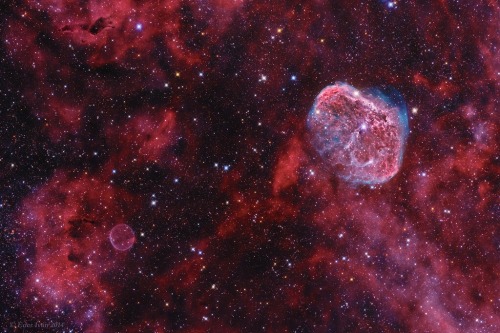
“Soap Bubble with Crescent, NGC6888” by Ivan Eder on Flickr.

Getting to Mars: 4 Things We’re Doing Now
We’re working hard to send humans to Mars in the 2030s. Here are just a few of the things we’re doing now that are helping us prepare for the journey:
1. Research on the International Space Station

The International Space Station is the only microgravity platform for the long-term testing of new life support and crew health systems, advanced habitat modules and other technologies needed to decrease reliance on Earth.

When future explorers travel to the Red Planet, they will need to be able to grow plants for food, atmosphere recycling and physiological benefits. The Veggie experiment on space station is validating this technology right now! Astronauts have grown lettuce and Zinnia flowers in space so far.

The space station is also a perfect place to study the impacts of microgravity on the human body. One of the biggest hurdles of getting to Mars in ensuring that humans are “go” for a long-duration mission. Making sure that crew members will maintain their health and full capabilities for the duration of a Mars mission and after their return to Earth is extremely important.

Scientists have solid data about how bodies respond to living in microgravity for six months, but significant data beyond that timeframe had not been collected…until now! Former astronaut Scott Kelly recently completed his Year in Space mission, where he spent a year aboard the space station to learn the impacts of microgravity on the human body.
A mission to Mars will likely last about three years, about half the time coming and going to Mars and about half the time on the Red Planet. We need to understand how human systems like vision and bone health are affected and what countermeasures can be taken to reduce or mitigate risks to crew members.
2. Utilizing Rovers & Tech to Gather Data

Through our robotic missions, we have already been on and around Mars for 40 years! Before we send humans to the Red Planet, it’s important that we have a thorough understanding of the Martian environment. Our landers and rovers are paving the way for human exploration. For example, the Mars Reconnaissance Orbiter has helped us map the surface of Mars, which will be critical in selecting a future human landing site on the planet.

Our Mars 2020 rover will look for signs of past life, collect samples for possible future return to Earth and demonstrate technology for future human exploration of the Red Planet. These include testing a method for producing oxygen from the Martian atmosphere, identifying other resources (such as subsurface water), improving landing techniques and characterizing weather, dust and other potential environmental conditions that could affect future astronauts living and working on Mars.

We’re also developing a first-ever robotic mission to visit a large near-Earth asteroid, collect a multi-ton boulder from its surface and redirect it into a stable orbit around the moon. Once it’s there, astronauts will explore it and return with samples in the 2020s. This Asteroid Redirect Mission (ARM) is part of our plan to advance new technologies and spaceflight experience needed for a human mission to the Martian system in the 2030s.
3. Building the Ride
Okay, so we’ve talked about how we’re preparing for a journey to Mars…but what about the ride? Our Space Launch System, or SLS, is an advanced launch vehicle that will help us explore beyond Earth’s orbit into deep space. SLS will be the world’s most powerful rocket and will launch astronauts in our Orion spacecraft on missions to an asteroid and eventually to Mars.

In the rocket’s initial configuration it will be able to take 154,000 pounds of payload to space, which is equivalent to 12 fully grown elephants! It will be taller than the Statue of Liberty and it’s liftoff weight will be comparable to 8 fully-loaded 747 jets. At liftoff, it will have 8.8 million pounds of thrust, which is more than 31 times the total thrust of a 747 jet. One more fun fact for you…it will produce horsepower equivalent to 160,000 Corvette engines!

Sitting atop the SLS rocket will be our Orion spacecraft. Orion will be the safest most advanced spacecraft ever built, and will be flexible and capable enough to carry humans to a variety of destinations. Orion will serve as the exploration vehicle that will carry the crew to space, provide emergency abort capability, sustain the crew during space travel and provide safe re-entry from deep space return velocities.
4. Making it Sustainable
When humans get to Mars, where will they live? Where will they work? These are questions we’ve already thought about and are working toward solving. Six partners were recently selected to develop ground prototypes and/or conduct concept studies for deep space habitats.

These NextSTEP habitats will focus on creating prototypes of deep space habitats where humans can live and work independently for months or years at a time, without cargo supply deliveries from Earth.

Another way that we are studying habitats for space is on the space station. In June, the first human-rated expandable module deployed in space was used. The Bigelow Expandable Activity Module (BEAM) is a technology demonstration to investigate the potential challenges and benefits of expandable habitats for deep space exploration and commercial low-Earth orbit applications.
Our journey to Mars requires preparation and research in many areas. The powerful new Space Launch System rocket and the Orion spacecraft will travel into deep space, building on our decades of robotic Mars explorations, lessons learned on the International Space Station and groundbreaking new technologies.
Make sure to follow us on Tumblr for your regular dose of space: http://nasa.tumblr.com

Crescent Nebula

Location: Hawaiian Island of Maui Photo: Jeff Berkes

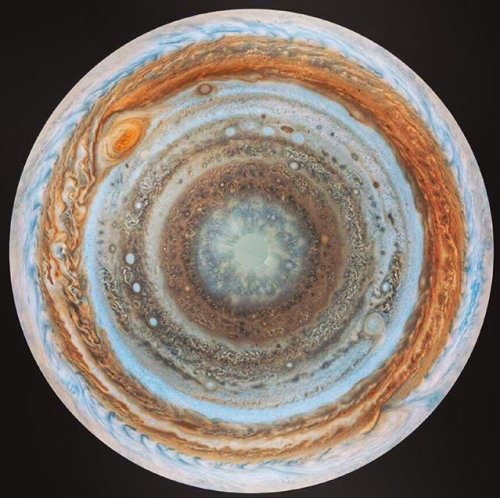
Jupiter’s south pole, taken by Cassini

TODAY IN HISTORY: The spectacular rings of Saturn, August 23, 1981, observed by the Voyager 2 space probe.

NGC 2736: The Pencil Nebula
js
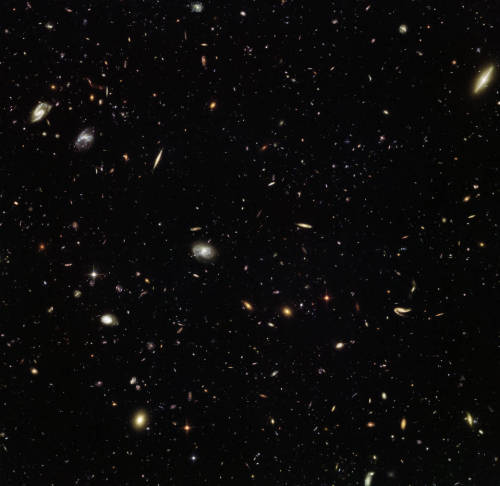
Hubble peers billions of light years away, uncovering thousands of colorful galaxies clustered together in the constellation of Leo (The Lion). Galaxy clusters are so massive that their immense gravity warps and amplifies the light from more distant objects. This phenomenon, known as gravitational lensing, can help astronomers reveal the earliest galaxies in our universe.

Three LEGO Minifigures Journey to Jupiter
Did you know that the Juno mission is also one giant leap for minifigure-kind? Three LEGO crew members have set their sights on being the first toy to visit another planet, enduring the five year, 1.75 billion mile journey aboard NASA’s Juno spacecraft. One minifigure is a likeness of Galileo Galilei – who discovered Jupiter’s four largest moons. The other two represent the Roman god Jupiter and his wife Juno. Each figure has been custom molded out of aluminum to represent their special characteristics. Jupiter carries a lightning bolt, Juno has a magnifying glass to represent her search for truth, Galileo is carrying a telescope and a model of the planet Jupiter.
To me, these minifigures add a beautifully ordinary and intensely human element to this extraordinary mission.
Explore more of the LEGO Group’s partnership with NASA at LEGO.com/Space

NGC 1275 Multi-Wavelength

ESO 540-030